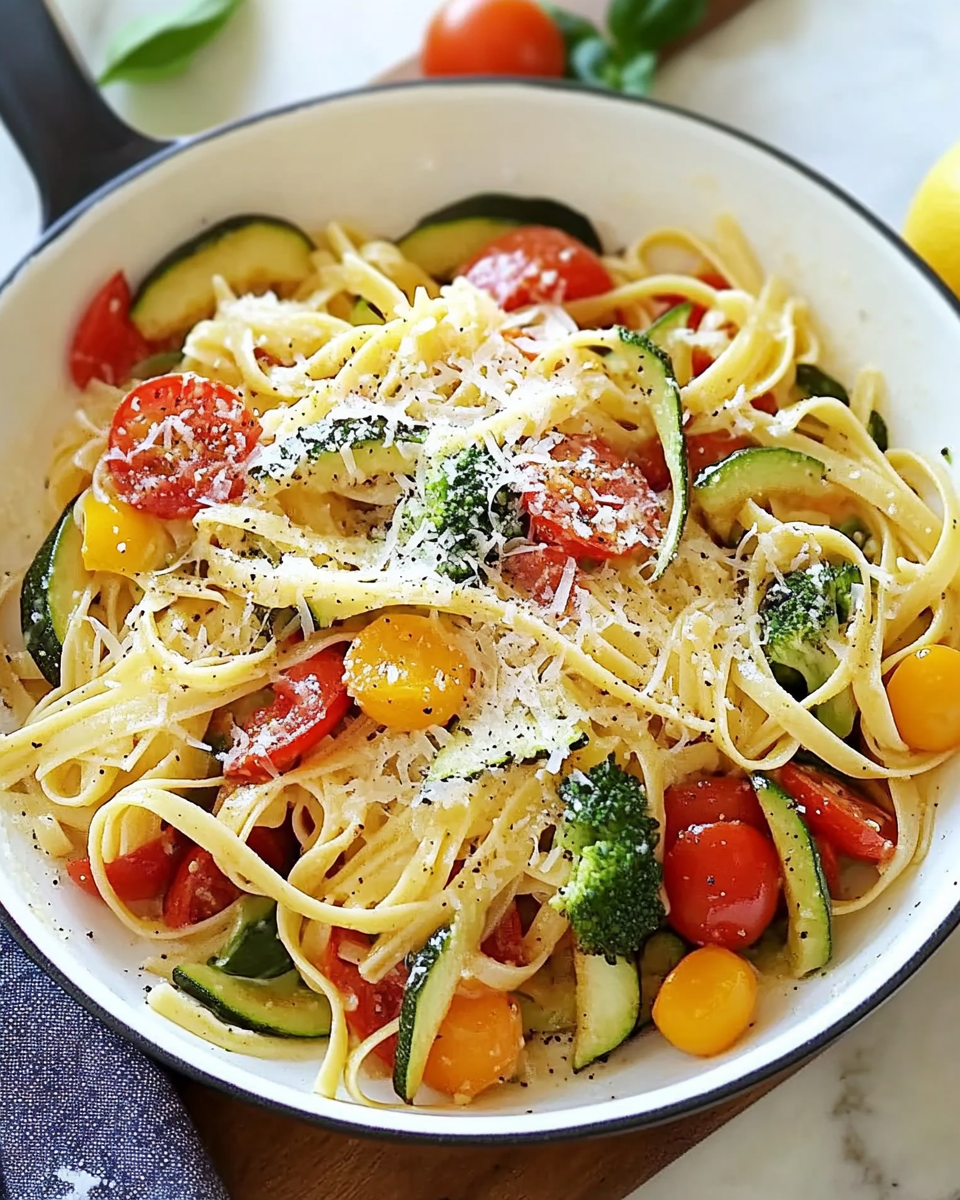Pasta Primavera is a celebration of fresh, colorful vegetables paired with perfectly cooked pasta and a burst of citrusy flavor from lemon juice. The dish is a light yet filling option for any time of the year, but it’s particularly perfect for warmer months when fresh produce is abundant.
The best part about Pasta Primavera is its versatility. You can switch out the vegetables based on what’s in season or what you have on hand. Whether you opt for a creamy sauce or keep it simple with just olive oil, this dish is guaranteed to be both nourishing and full of flavor.
Full recipe:
Ingredients:
-
1 lb pasta (spaghetti or your choice)
-
1 tablespoon olive oil
-
1 zucchini, sliced
-
1 yellow squash, sliced
-
1 cup cherry tomatoes, halved
-
1/2 cup bell peppers, sliced
-
1/2 cup broccoli florets
-
2 cloves garlic, minced
-
1/2 cup grated Parmesan cheese
-
1/4 cup fresh basil, chopped
-
Salt and pepper to taste
-
1/2 cup heavy cream (optional for a creamy finish)
-
1 tablespoon lemon juice
-
1/4 teaspoon red pepper flakes (optional)
Directions:
-
Cook the pasta according to package instructions, then drain and set aside.
-
Heat olive oil in a large skillet over medium heat. Add the zucchini, yellow squash, bell peppers, and broccoli. Sauté for 5-6 minutes until vegetables are tender.
-
Add the garlic and cook for an additional 1-2 minutes.
-
Add the cherry tomatoes and cook for another 2 minutes, allowing them to soften.
-
Stir in the cooked pasta, Parmesan cheese, and lemon juice. Toss to combine. If desired, add heavy cream for a creamy sauce and season with salt, pepper, and red pepper flakes.
-
Garnish with fresh basil and serve immediately.
Prep Time: 10 minutes | Cooking Time: 15 minutes | Total Time: 25 minutes
Kcal: 300 kcal | Servings: 4 servings
The Origins of Pasta Primavera
The origins of Pasta Primavera can be traced back to the 1970s when it was reportedly created in New York City at the famous restaurant, Le Cirque. While it is often associated with Italian cuisine, Pasta Primavera was actually an American invention, designed to showcase the best of fresh vegetables during the spring and summer months. Over the years, this dish has become a beloved classic in many households and restaurants worldwide, with each chef and home cook adding their own spin to the original recipe.
Why Pasta Primavera is So Popular
What makes Pasta Primavera so appealing is its simplicity. At its core, it’s a dish that celebrates fresh, seasonal vegetables paired with pasta and a light sauce. The colorful mix of vegetables, such as zucchini, bell peppers, and tomatoes, creates an inviting, vibrant plate that is as beautiful as it is delicious. Additionally, the use of ingredients like olive oil, garlic, and lemon brings out the natural flavors of the vegetables, making the dish refreshing and full of bright flavors.
The beauty of Pasta Primavera lies in its flexibility. While the basic recipe calls for a mix of seasonal vegetables and a simple sauce, it can be easily customized to suit dietary preferences and available ingredients. For instance, you can opt for gluten-free pasta or a dairy-free cream alternative to make it suitable for vegan or gluten-intolerant guests. Whether you want a creamy version or a lighter, oil-based sauce, Pasta Primavera can be adapted to fit your needs.
The Health Benefits of Pasta Primavera
Pasta Primavera is a nutrient-packed dish that provides a variety of health benefits. The vegetables used in this dish are rich in vitamins, minerals, and antioxidants, making it a great option for those looking to increase their vegetable intake. For example, zucchini is an excellent source of vitamin C, which helps to boost the immune system, while tomatoes are packed with lycopene, an antioxidant that has been linked to heart health. Bell peppers are high in vitamin A, which promotes good vision and skin health, and broccoli is a powerhouse vegetable that is full of fiber and vitamin K, important for bone health.
The dish also offers a good balance of carbohydrates from the pasta, healthy fats from olive oil, and protein from Parmesan cheese, making it a well-rounded meal. If you add some grilled chicken, shrimp, or even tofu, you can easily increase the protein content for a more filling option. Because of its use of whole foods, Pasta Primavera is not only delicious but also a nourishing meal for your body.
How to Customize Your Pasta Primavera
One of the main appeals of Pasta Primavera is how easily it can be customized to suit different tastes and preferences. You can modify the recipe based on what vegetables are in season, what you have in your pantry, or what flavors you want to highlight.
Vegetable Variations: While the traditional recipe calls for zucchini, bell peppers, cherry tomatoes, and broccoli, you can experiment with a wide variety of vegetables. Asparagus, peas, spinach, or even mushrooms can be great additions. The key is to use vegetables that have different textures and flavors to create a satisfying balance.
Adding Protein: If you want to make your Pasta Primavera more substantial, consider adding a source of protein. Grilled chicken or shrimp are popular options, but you could also use plant-based proteins like tofu or chickpeas for a vegetarian or vegan twist. The added protein makes the dish more filling and satisfying, perfect for a complete meal.
Sauce Options: Although Pasta Primavera is typically made with a simple olive oil and garlic sauce, you can easily make it creamier by adding heavy cream or a dairy-free cream alternative. Some recipes also include a touch of Parmesan cheese to give the sauce a richer flavor. If you prefer a lighter version, simply drizzle the pasta and vegetables with olive oil and toss with a squeeze of fresh lemon juice for brightness. You can also add a sprinkle of red pepper flakes for a little heat, or fresh herbs like basil, parsley, or oregano for extra flavor.
The Perfect Pasta to Use for Primavera
While most recipes call for spaghetti, you can use any type of pasta that you prefer or have on hand. Long, thin pastas like linguine, fettuccine, or angel hair are great choices, as they allow the vegetables to be wrapped around the strands of pasta. For a heartier option, consider using whole wheat pasta or gluten-free pasta to meet dietary needs. Pasta shapes like penne or fusilli are also popular, as their nooks and crannies catch the sauce and vegetables, ensuring that each bite is flavorful.
How to Serve Pasta Primavera
Pasta Primavera is an incredibly versatile dish, making it perfect for a variety of occasions. It can be served as a light lunch or dinner, paired with a side salad and some garlic bread for a complete meal. If you’re hosting a dinner party or gathering, Pasta Primavera is a great choice as a side dish, especially when paired with grilled meats or seafood.
If you prefer a heartier meal, you can add protein directly to the dish, such as grilled chicken or shrimp, or even tofu for a vegetarian alternative. The dish also works well as a meal prep option, as the vegetables and pasta store well in the refrigerator for a few days, making it easy to reheat and enjoy throughout the week.
Making Pasta Primavera Ahead of Time
One of the great things about Pasta Primavera is that it can be prepared ahead of time. You can cook the pasta and vegetables separately and store them in the fridge for up to a few days. When you’re ready to serve, simply heat the vegetables and toss them with the pasta, Parmesan, and sauce. If you want a creamy sauce, you can prepare it ahead of time and store it separately in the fridge. Just be sure to reheat the sauce gently to avoid curdling.
Pairing Pasta Primavera with Wine
Pasta Primavera, with its light, fresh flavors, pairs beautifully with crisp white wines. A dry Sauvignon Blanc or Pinot Grigio would complement the dish perfectly, enhancing the freshness of the vegetables and the lemony notes in the sauce. If you prefer red wine, a light-bodied Pinot Noir can also be a good match, offering subtle berry notes that won’t overpower the dish. For a non-alcoholic option, a sparkling water with a splash of lemon or lime would be refreshing and enjoyable.
Conclusion
Pasta Primavera is a dish that beautifully captures the essence of fresh, seasonal ingredients. Its versatility, ease of preparation, and vibrant flavors make it an ideal choice for any occasion, from casual weeknight dinners to more formal gatherings. Whether you stick to the traditional recipe or customize it with your favorite vegetables and proteins, Pasta Primavera is sure to become a go-to recipe in your kitchen. Its light yet satisfying nature makes it the perfect meal for anyone looking to enjoy a healthy, flavorful dish that celebrates the best of what each season has to offer.






